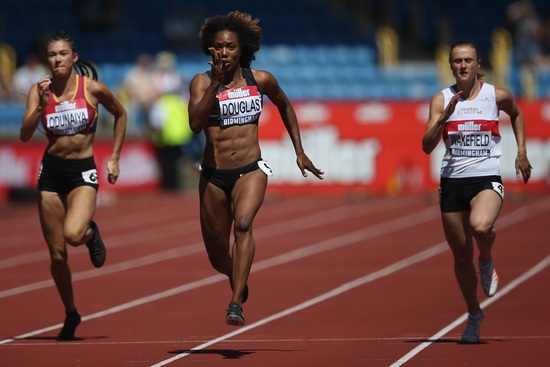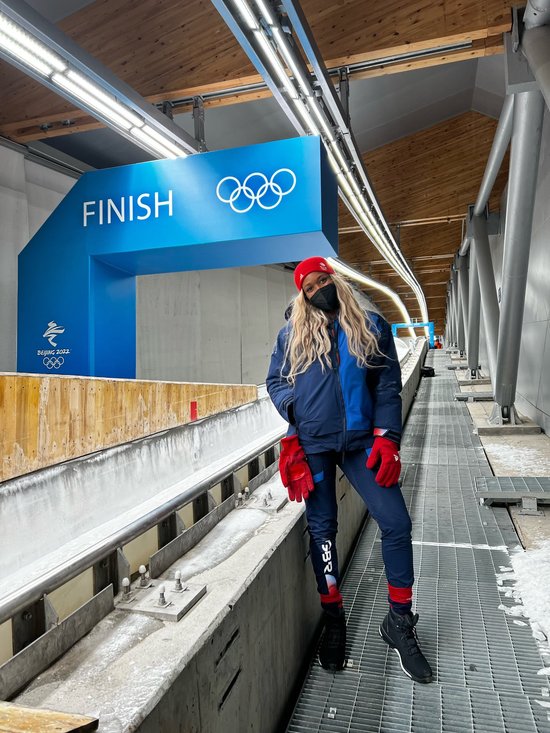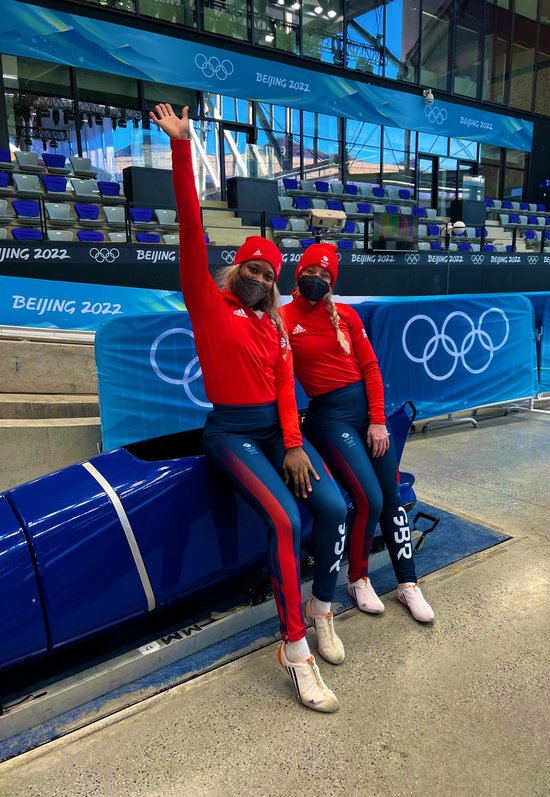Montell Douglas, running the 100 meters, photo by British Athletics
RelatedPosts
Montell Douglas, 2022 Beijing Olympics, photo by @rekords on Instagram and British Bobsleigh & Skeleton Association
When Stuart Weir sent me these two pieces on Montell Douglas, he asked me to get them posted in the next week. I am keeping the promise. Then, I remembered, I had met Montell in 2012. In fact, Montell and I did a BBC World radio broadcast together during the London 2012 closing ceremony. She was a lot of fun to chat with, and I loved the articles that Stuart had done on Montell and her transition to the Winter Olympics.
I was familiar with US athletes who had done such things, from Willie Davenport, and Edwin Moses to LoLo Jones and Lauryn Williams. This two-parter is a big deal. Stuart helps us appreciate the challenges for a track athlete moving to the bobsleigh.
Montell Douglas: The transition from track to bobsleigh
One of the first things former Olympic sprinter, Montell Douglas, feels that she brings to bobsleigh as she prepares for the winter Olympics is her mental strength. “I think I brought my tenacity. I do like to push myself. I like to learn new things and to apply them. I say: ‘how can I push this; how can I be better?’ When it’s late on in your career and you’re changing sports, you need to do this and you need to do it quickly because you don’t have time to waste and not be learning stuff. So those are some things I hope I’ve brought. I think I also brought perspective. And I hope I’ve been a good teammate to the other girls”.
When she was recruited, she was told that bobsleigh required “bigger, faster, stronger girls”. She explains further: “It also depends what kind of athlete you are. In an Olympic 100m final eight girls line up but they’re different kinds of athletes – some taller, some smaller, some stronger – each with different attributes. Not all of them would necessarily do well in a bob. It depends on what kind of athlete you are and what you’re bringing to the table. People from the outside look at bobsleigh and say ‘Oh, you are running and pushing’ but there’s more to it than just sprinting behind the bob! I had to work on developing my attributes a lot”.
Monty is tall, which she thinks is an advantage in her new sport: “I think that bobsleigh people would generally say tall is good. They want tall, strong, heavier, powerful girls who can move quickly. That would be the ideal bobsleigher. But bobsleighers, across the board, look very different. I am tall but I have very long limbs. So it’s not just that I’m 5:10, I have almost got 6:2 limbs. In some ways that’s a challenge to be behind the bob, which, for me, is very low but you have to work around things and find a way to get the job done. And I’ve had a lot of good coaches around me to narrow that gap”.
Montell Douglas, 2022 Beijing Olympics, photo by @rekords on Instagram and British Bobsleigh & Skeleton Association
The requirements of speed and strength have to be balanced. I remember Toni Minichiello, saying of heptathlete, Jess Ennis, that she would throw further if she was heavier but then she would be slower in the sprints. He described the coaching problem as spinning plates. Monty applies the dilemma to bobsleigh: “I’ve gained 10 kilos compared to my first Olympic Games. I’m a lot heavier because you need the mass to move the bobsleigh and of course, the weight is going to slow me down so I had to balance those components to ensure that my performance was still at the high level that it needed to be”.
There were further adjustments to make as she sought to apply her sprinting talents to the task of pushing a bob: “I think for me it was a steeper learning curve because, when I evaluated it, to see what I had to do to get behind the bob and get better, I had to find ways to do that, techniques, and not just react to what I was being taught. I’m an “in-flight sprinter” [Meaning the best part of my running is when I’m at a maximum velocity… the time between 30-60m, for example] and my best part is when I’m in-flight and I have to work so hard at my acceleration to build that up as a fast start is essential in bobsleigh”.
She also thinks that perhaps different sports attract different people types: “There are the different personality types in sport. And you could say that most winter sports are extreme sports. As an athlete, I was running a straight line. That requires me to be athletic but there’s nothing extreme about it and I think the personality types are extremely important for the sport you going to do. That adds to it and the reason we’re good at it is perhaps that our character is a bit manic. You do have to be a bit nuts to throw yourself down an ice mountain at 80-90mph. I was going to say was no brakes – but you don’t want the brakes on to achieve the results you want!
“In athletics, sprinters are not like marathon runners. A long jumper is not similar to a pole vaulter. Often they have different personalities. In my athletics days I would often stay up very late when you’re supposed to go to bed early but sprinters, generally, do that. Perhaps it was our personality type and is that why we were sprinters? I think it’s the same with the bob and winter sports”.
The aim of competing in the Olympics is to win a medal and Monty is ambitious but realistic: “You don’t want to focus on the medal but on the performance and the process because you can’t actually impact the result. All you can do is your best. And your best might equal the top 10 or it might equal the top three. You can set realistic goals but at the same time you need to focus on doing your job and that means preparation and making sure we’re the healthiest, fittest, fastest, strongest that we’ve ever been”.
The Women’s Bobsleigh takes place on 18 and 19 February.
Author
We are The Shoe Addicts showing our love of Track and Field among many other sports. We make videos, we have fun doing it. Contact: shoeaddictsllc@gmail.com
View all posts





















